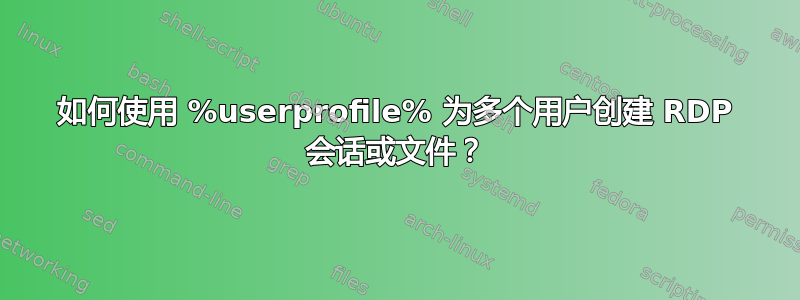
我有此代码来设置 RDP 连接管理器,但需要它才能将 MSTSC 用于多个用户,这些用户因计算机而异。我尝试使用 %userprofile%\desktop\Desktop.rdp,但它无法正常工作。这是我使用的代码
###########################################################################
#
# NAME: New-MSTSCFile.ps1
#
# AUTHOR: Markus Lassfolk
# EMAIL: [email protected]
#
# Original AUTHOR: Jan Egil Ring
# EMAIL: [email protected]
#
# COMMENT: Script to create an txt-file for use with Microsoft Remote Desktop Connection Manager
# For more details, see the following blog-post: http://blog.powershell.no/2010/06/02/dynamic-remote-desktop-connection-manager-connection-list
#
# You have a royalty-free right to use, modify, reproduce, and
# distribute this script file in any way you find useful, provided that
# you agree that the creator, owner above has no warranty, obligations,
# or liability for such use.
#
# VERSION HISTORY:
# 2.1 19/08/2015 - Creating a Default Profile based on your UserName and Domain
# - Assume RDGW Address is rdgw.your.domain.fqdn if incorrect, set it manually.
#
# 2.0 15/07/2015 - Updated for MSTSC 2.7
# - Only including ComputerObjects (no ClusterNames etc)
# - Only including Enabled Computer objects
# - Adds Computer Description as Comment
# - Not using a Group. Felt no need for that as there is just one environment in each RDG File
# - Support for Providing a RDGateway Address
# - Changed file name to reflect FQDN of Domain (we have several customers with the same Netbios name)
# - Sort servers alphabetically in the list.
#
# 1.0 02.06.2010 - Initial release
#
###########################################################################
#Importing Microsoft`s PowerShell-module for administering Active Directory
Import-Module ActiveDirectory
#Initial variables
$EnableRDGW = $true # set to: $false if RDGW should not be used
$RDGW = "rdgw.cmrinc.com" # Enter External RDGW Address if this is incorrect.
#$domain = $env:userdomain
$OutputFile = "$home\desktop\CMR_Desktop.rdg"
#Create a template txt
$template = @'
screen mode id:i:2
use multimon:i:0
desktopwidth:i:1920
desktopheight:i:1080
session bpp:i:24
winposstr:s:0,3,0,0,800,600
compression:i:1
keyboardhook:i:2
audiocapturemode:i:1
videoplaybackmode:i:1
connection type:i:2
networkautodetect:i:0
bandwidthautodetect:i:1
displayconnectionbar:i:1
enableworkspacereconnect:i:0
disable wallpaper:i:1
allow font smoothing:i:0
allow desktop composition:i:0
disable full window drag:i:1
disable menu anims:i:1
disable themes:i:0
disable cursor setting:i:0
bitmapcachepersistenable:i:1
full address:s:rdshost.cmrinc.com
audiomode:i:0
redirectprinters:i:0
redirectcomports:i:0
redirectsmartcards:i:0
redirectclipboard:i:1
redirectposdevices:i:0
autoreconnection enabled:i:1
authentication level:i:0
prompt for credentials:i:0
negotiate security layer:i:1
remoteapplicationmode:i:0
alternate shell:s:
shell working directory:s:
gatewayhostname:s:rdsgw.cmrinc.com
gatewayusagemethod:i:1
gatewaycredentialssource:i:4
gatewayprofileusagemethod:i:1
promptcredentialonce:i:1
gatewaybrokeringtype:i:0
use redirection server name:i:0
rdgiskdcproxy:i:0
kdcproxyname:s:
drivestoredirect:s:
set audioqualitymode:1:2
span monitors:i:0
use multimon:i:0
session bpp:i:24
'@
#Output template to txt-file
$template | Out-File $home\CMR_Desktop.rdp l
#Load template into txt object
$txt = New-Object text
$txt.Load("$home\CMR_Desktop.rdp")
#Set file properties
$file = (@($txt.MSTSC.file.properties)[0]).Clone()
$file.name = "CMR_Desktop.rdp"
$txt.MSTSC.file.properties | Where-Object { $_.Name -eq "" } | ForEach-Object { [void]$txt.MSTSC.file.ReplaceChild($file,$_) }
# Set RDGW Server Address
if ($EnableRDGW -eq $true) {
$txt.MSTSC.file.gatewaySettings.hostName = $RDGW
$txt.MSTSC.file.gatewaySettings.enabled = "True"
}
# Create a Profile with your current username and domain
$txt.MSTSC.file.credentialsProfiles.credentialsProfile.profileName.'#text' = "CMR_Desktop.r"
$txt.MSTSC.file.credentialsProfiles.credentialsProfile.userName = "InfinityText"
$txt.MSTSC.file.credentialsProfiles.credentialsProfile.domain = "CMRINC.com"
$txt.MSTSC.file.logonCredentials.profileName.'#text' = "InfinityTest"
$txt.MSTSC.file.gatewaySettings.profileName.'#text' = "InfinityTest"
#Use template to add servers from Active Directory to txt
$server = (@($txt.MSTSC.file.server)[0]).Clone()
#get-adcomputer -LDAPFilter "(&(objectCategory=computer)(operatingSystem=Windows Server*)(!serviceprincipalname=*MSClusterVirtualServer*)(!(userAccountControl:1.2.840.113556.1.4.803:=2)))" -Property name,dnshostname,description | sort-object Name | select name,dnshostname,description |
ForEach-Object {
$server = $server.clone()
$server.DisplayName = $_.Name
$server.Name = $_.DNSHostName
if ($_.Description -ne $Null) {
$server.comment = $_.Description
}
else {
$server.comment = ""
}
#
$txt.MSTSC.file.AppendChild($server) > $null}
#Remove template server
#`$txt.MSTSC.file.server | Where-Object { $_.Name -eq "" } | ForEach-Object { [void]$txt.MSTSC.file.RemoveChild($_) }
#Save txt to file
$txt.Save($OutputFile)
#Remove template txt-file
Remove-Item $home\MSTSC-template.txt -Force
Write-Output "$OutputFile Created"
它具有我的 RDP 会话的所有设置。
答案1
第一个 Powershell 脚本是创建 RDP 文件
#Create RDP
New-Item -Path ~\desktop\ -Name 'CMR Desktop.rdp' -ItemType file
#Config RDP Settings
#invoke-expression -Command .\Config_RDP_Settings.ps1
& .\Config_RDP_Settings.ps1
#Pauses the process
Pause
然后用我想要的参数配置文件,因为创建的文件是一个空文件
#Add setting to CMR Desktop.rdp file
ls "~\desktop\CMR Desktop.rdp" | %{ "screen mode id:i:2" | Out-File $_.FullName -
append -encoding ASCII}
ls "~\desktop\CMR Desktop.rdp" | %{ "session bpp:i:24" | Out-File $_.FullName -append
-encoding ASCII}
ls "~\desktop\CMR Desktop.rdp" | %{ "winposstr:s:0,3,0,0,800,600" | Out-File
$_.FullName -append -encoding ASCII}
ls "~\desktop\CMR Desktop.rdp" | %{ "compression:i:1" | Out-File $_.FullName -append
-encoding ASCII}
ls "~\desktop\CMR Desktop.rdp" | %{ "keyboardhook:i:2" | Out-File $_.FullName -append
-encoding ASCII}
我必须对 RDP 会话文件中所需的每个设置执行此操作


